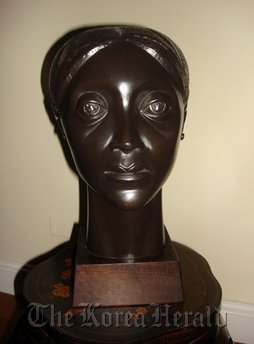NEW YORK (AP) ― When American sculptor and printmaker Elizabeth Catlett was a graduate student studying with Grant Wood in Iowa, the painter of the iconic “American Gothic” told his young student to make art about what she knew best.
Catlett, who was born into a middle-class family in Washington, D.C., in 1915 and raised by her mother and grandmother, took Wood’s advice to heart and began making images of strong and beautiful black women.
This week the Bronx Museum is opening a show that features a broad range of drawings, prints and sculptures by Catlett, who will be 96 in April. Guest curator Isolde Brielmaier displays Catlett’s work alongside pieces in a variety of media by 21 younger artists who explore some of Catlett’s signature issues, including racial identity, family dynamics and social and political struggle, but in an edgier, more allusive way.
Catlett, who was born into a middle-class family in Washington, D.C., in 1915 and raised by her mother and grandmother, took Wood’s advice to heart and began making images of strong and beautiful black women.
This week the Bronx Museum is opening a show that features a broad range of drawings, prints and sculptures by Catlett, who will be 96 in April. Guest curator Isolde Brielmaier displays Catlett’s work alongside pieces in a variety of media by 21 younger artists who explore some of Catlett’s signature issues, including racial identity, family dynamics and social and political struggle, but in an edgier, more allusive way.

The show coincides with Black History Month, the annual attempt to acknowledge the extraordinary contributions of a large swath of the population whose accomplishments are largely overlooked at other times of the year.
With its formal beauty and universal themes, Catlett’s artwork does not need a commemorative month to be celebrated. At the same time, her work draws much of its dynamic form and emotional energy from her investigation of racial and ethnic identity.
Catlett, who knew from age 6 that she wanted to be an artist, has always been clear about the purpose of her work. In a video at the entrance to the show, she explains that Harriet Tubman and Paul Robeson ― two icons of black freedom ― inspired her, and that she wanted to express herself in art as singer and actor Robeson had done in music and drama.
It is no coincidence that the heroic proportions of her sculpture evoke the idealizing tendency of classical Greek sculpture. Or that her smooth, stylized faces are less about individual people and more about the dignity and nobility of universal man, woman and child.
This is sculpture that is meant to comfort, uplift and inspire. Her prints, on the other hand, express her lifelong commitment to use art as a tool for social change, often incorporating the slogans (“Black Is Beautiful”) and revolutionary heroes (Angela Davis and Malcolm X) of the civil rights and black power movements.
In retrospect, Catlett seems to have led a charmed life, witnessing nearly every important artistic and social movement of the 20th century and traveling in some of the same illustrious circles as the great American artist Jacob Lawrence and poet Langston Hughes.
Most of the younger artists whose work is displayed with Catlett’s came of age after the major battles of the civil rights movement had been fought. While it is true they will never know what it was like to live under segregation and inequality, it is also clear they struggle with other forms of oppression, including the violence and materialism of contemporary American pop culture.
Mickalene Thomas explores 1970s-era images of black female beauty and interior design in large-scale color portraiture including “Portrait of Qusuquzah,” while Sam Durant photographs the broken mannequin of an American Indian woman to evoke cultural dislocation and genocide. Other striking works in the show include Hank Willis Thomas’ gold pendant with the abolitionist image of a kneeling slave and the slogan, “Am I not a man and a brother?” The slave’s uplifted hands hold a large diamond ― actually cubic zirconia ― transforming the piece into a scathing commentary on the bling values of hip-hop culture.
Shinique Smith’s soft sculpture of cast-off clothing and toys bound together in a large, rectangular bale recalls the heaps of clothing our throwaway society ships to the developing world. As a reminder of the global economy’s unequal distribution of wealth, Smith’s piece echoes the strong social conscience that has long distinguished Catlett’s large and important body of work.
The show will be on view through May. 29. The Bronx Museum is the sole stop.





![[From the Scene] Monks, Buddhists hail return of remains of Buddhas](http://res.heraldm.com/phpwas/restmb_idxmake.php?idx=644&simg=/content/image/2024/04/19/20240419050617_0.jpg&u=20240419175937)





![[Graphic News] French bulldog most popular breed in US, Maltese most popular in Korea](http://res.heraldm.com/phpwas/restmb_idxmake.php?idx=644&simg=/content/image/2024/04/18/20240418050864_0.gif&u=)


![[From the Scene] Monks, Buddhists hail return of remains of Buddhas](http://res.heraldm.com/phpwas/restmb_idxmake.php?idx=652&simg=/content/image/2024/04/19/20240419050617_0.jpg&u=20240419175937)

![[KH Explains] Hyundai's full hybrid edge to pay off amid slow transition to pure EVs](http://res.heraldm.com/phpwas/restmb_idxmake.php?idx=652&simg=/content/image/2024/04/18/20240418050645_0.jpg&u=20240419100350)

![[Today’s K-pop] Illit drops debut single remix](http://res.heraldm.com/phpwas/restmb_idxmake.php?idx=642&simg=/content/image/2024/04/19/20240419050612_0.jpg&u=)